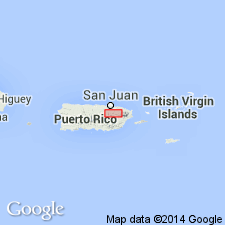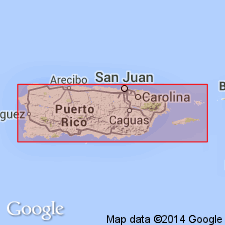
- Usage in publication:
-
- Camarones Sandstone*
- Modifications:
-
- Named
- Dominant lithology:
-
- Siltstone
- Sandstone
- Conglomerate
- AAPG geologic province:
-
- Caribbean region
Summary:
The Camarones Sandstone, here named, was included in the Hato Puerco Tuff by previous writers. Consists of well-bedded, calcareous, dark-gray, thin-bedded tuffaceous siltstone interstratified with tuffaceous wacke and conglomerate. Includes the Mamey Lava Member. Base is indeterminate; interfingers with the Santa Olaya Lava; conformably underlies the Tortugas Andesite. Stratigraphically equivalent to the Rio de la Plata Sandstone. Maximum thickness is 680 m. Age is Late Cretaceous (Coniacian).
Source: GNU records (USGS DDS-6; Reston GNULEX).

- Usage in publication:
-
- Camarones Sandstone*
- Modifications:
-
- Overview
- AAPG geologic province:
-
- Caribbean region
Summary:
The Camarones Sandstone occurs in eastern Puerto Rico and consists of locally carbonaceous volcaniclastic siltstone interbedded with tuffaceous sandstone, and minor volcanic conglomerate, local lava flows. Maximum thickness is 950 meters. The Camarones is of Late(?) Cretaceous age.
Source: GNU records (USGS DDS-6; Reston GNULEX).
For more information, please contact Nancy Stamm, Geologic Names Committee Secretary.
Asterisk (*) indicates published by U.S. Geological Survey authors.
"No current usage" (†) implies that a name has been abandoned or has fallen into disuse. Former usage and, if known, replacement name given in parentheses ( ).
Slash (/) indicates name conflicts with nomenclatural guidelines (CSN, 1933; ACSN, 1961, 1970; NACSN, 1983, 2005, 2021). May be explained within brackets ([ ]).

